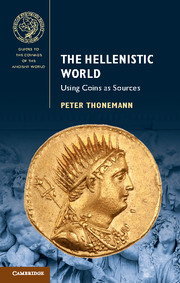Book contents
- Frontmatter
- Contents
- List of maps
- List of figures
- Preface
- List of abbreviations
- Maps
- Part I Globalization
- Part II Identity
- Part III Political economy
- Part IV Ideology
- Guide to further reading
- Appendices (by Andrew Meadows)
- 1 Glossary of numismatic terms
- 2 Denominational systems
- 3 The manufacture and material of ancient coinage
- Bibliography
- Index
1 - Glossary of numismatic terms
from Appendices (by Andrew Meadows)
Published online by Cambridge University Press: 05 December 2015
- Frontmatter
- Contents
- List of maps
- List of figures
- Preface
- List of abbreviations
- Maps
- Part I Globalization
- Part II Identity
- Part III Political economy
- Part IV Ideology
- Guide to further reading
- Appendices (by Andrew Meadows)
- 1 Glossary of numismatic terms
- 2 Denominational systems
- 3 The manufacture and material of ancient coinage
- Bibliography
- Index
Summary
AuthorityThe formal guarantor of the value of a coin. For civic coinages, the authority is generally presumed to be the government of the city itself. Within kingdoms and empires, the authority may be the supreme ruler (e.g. king or emperor), or an appointee (e.g. satrap or provincial governor).
AxisSee Die-axis
CirculationThe movement of coinage once it has been issued. The circulation of ancient coinage can be studied through the evidence of hoards and single finds, as well as from documentary sources.
Circulation wearThe wear (or deterioration in condition) visible on a coin due to the time it has spent in circulation.
Control-markA mark or symbol of some kind, generally on the reverse of a coin, apparently indicating some aspect of the administration of coin production.
CountermarkA mark in the form of letter(s), a symbol, a monogram or a combination of these punched into a coin after its minting. The reason for the application of such marks is not always certain, and probably varied from case to case. Some served to reauthorize a coin for circulation in new areas. Others perhaps assigned new denominations to old coins.
DenominationThe value of an ancient coin. These values are generally expressed in a standard set of units, subdivisions and multiples. See futher below: Denominational systems, pp. 197–8.
DieA piece of metal engraved with a design and then used to strike coins. Two dies were required to strike the two faces of a coin: the obverse die and the reverse die.
Die-axisThe relative orientation of obverse and reverse images on a coin.
Die-engraverThe artist responsible for the engraving of the design on to dies. They are generally anonymous on ancient coinage, although a few signatures are recorded, particularly in late fifth-century Sicily.
Die studyA technical numismatic study of a coinage that involves the identification of the dies used to strike a coinage. Such studies allow for the establishment of the relative chronology of a coinage. They also permit quantification of a coinage by identifying the number of dies used to produce a given coinage.
Die-wearThe wear, or damage, experienced by a die in the course of its use to strike coins. This may take the form of gradual deterioration or sudden breaks.
- Type
- Chapter
- Information
- The Hellenistic WorldUsing Coins as Sources, pp. 193 - 196Publisher: Cambridge University PressPrint publication year: 2016

